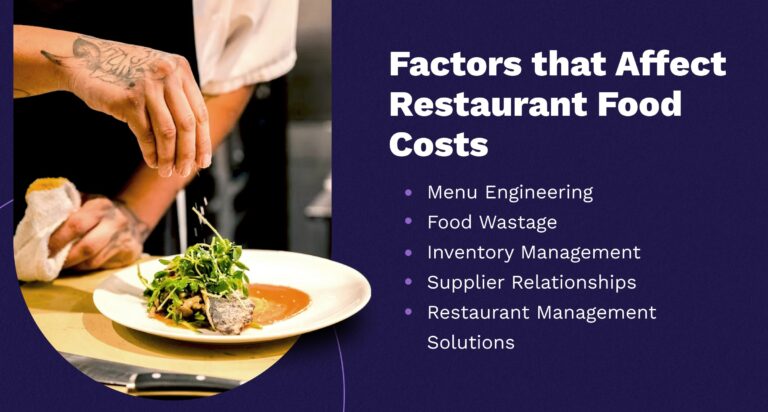Restaurant Cost Control: Common Areas of Wastage & How to Avoid Them
Maximise profitability by managing your food costs
Understanding restaurant cost control
Restaurant cost control is one of the key concerns involved in managing a restaurant. To stay competitive, restaurants have to spend on improvements like recipes, menu design, customer service, and more.
Food costs are a major component of these factors, and also one of the trickiest to handle. In this article, we share the common factors that affect food cost, and how best to avoid wastage in order to maximise profitability.
Before you delve into the best practices of restaurant cost control, you first need to identify your unique selling points (USP) and the target audience of your business. For example, if your restaurant leans towards fine dining, much of the emphasis would be placed on the quality of produce used and the seasonality of ingredients. You can naturally anticipate higher costs and shorter shelf lives for such products. Consumers would also expect to pay more at such establishments, so dishes can be priced higher for bigger profits.
1. Engage in menu analysis to encourage sales
Menu analysis, also known as menu engineering, is focused on the pricing, popularity, and profitability of your menu items.
Capitalising on trends & upselling seasonal items
As briefly mentioned above, if your restaurant relies on the freshness and seasonality of produce (e.g. pumpkins in autumn and Japanese yellowtail in winter) you might find yourself having to switch up your menu offerings regularly.
If you’re using physical menus, it’s more cost-effective to ensure your menu design is lightweight (less photos, smaller sizes) and easy to change, in order to save on time and printing costs. Otherwise, you could consider making the switch to digital instead.
Businesses who want to capitalise on seasonality and trends can also work with their chefs to whip up one or two special dishes (the same way Starbucks offers seasonal drinks), and set higher price points for these items. You could also consider making seasonal items into add-ons that you can upsell, like offering white truffle shavings or toppings of fresh uni onto pasta dishes. This potentially increases your average order value.
The psychology of price
Creating a sense of value or lower prices by using price psychology can do wonders for managing food cost for restaurants. There’s a reason why so many items are priced with a .99 or .90 value. Customers might be conscious of what you’re doing when you charge $13.90 instead of $14 for a burger, but they still somehow register it as a measurably better deal.
Other times, you can offer an extremely profitable item for a steep discount or in a bundle to create perceived value.
The most profitable items are not always the best
It is good practice to regularly examine which menu items are doing well and which are not. While some dishes might be profitable, they might not be popular—discuss with your kitchen team if this is an issue of limited demand or of over-pricing.
2. Control food wastage to lower costs
Lowering wastage is crucial in restaurant cost control. Wastage can occur in many instances, like when food is spilled, burnt, past its best-by date, or when it’s returned to the kitchen by diners.
Often, wastage can also occur when diners are repeatedly leaving their meals unfinished. This could be a case of portion control, and it’s down to the kitchen team to determine the ideal portion sizes for each dish.
While some wastage is unavoidable, most of these instances can be mitigated with proper staff training and inventory management. Avoiding food wastage requires a deep understanding of demand, and this includes actively tracking the average size of orders and peak periods.
3. Maintain good relationships with multiple food suppliers
A good relationship with your suppliers goes so much further than the transactions you make. By communicating with them frequently, setting your expectations, and building mutual trust and respect, they can help you reduce costs with preferential and consistent rates. This is especially important in an industry that’s prone to supply chain disruptions from fluctuating prices (due to inflation, natural disasters, animal disease outbreaks, etc.).
Furthermore, your suppliers are specialists in the F&B industry, which means they’re often a knowledgeable source on what goods to purchase and upcoming F&B trends. Make sure to have multiple suppliers so you’re not dependent on a singular source!
At the end of the day, spending less time worrying about your supply chain means you can turn your focus onto other aspects of your business.
4. Explore digital solutions that improve restaurant cost control
There is a wide variety of restaurant management solutions that allow you to accurately track and estimate the demand for your restaurants.
For those offering delivery & takeaway services, having your own e-Shop could help with inventory management. Bakeries and pâtisseries, for example, could benefit from setting their own lead times or pre-order requirements that will give them information on expected demand. Raw ingredient ordering and production can then be done in bulk, minimising wastage.
Similarly, restaurants expecting a high volume of orders for festive occasions like Christmas and Lunar New Year can choose to operate e-Shops just for the season.
When it comes to anticipating dine-in demand, a reservation system—especially one that allows for deposits and pre-payments—is ideal for restaurant cost control, and is also useful for collecting data like average table size and order value.
Oddle’s omnichannel solutions include both a white-label e-Shop for delivery & takeaways, as well as a reservations platform that’s free of charge. Besides managing food cost in restaurants, our solutions allow you to collect, own, and analyse customer data to understand demand. Most importantly, you’ll be able to save on cover charges, commissions, and unnecessary fees charged by marketplace apps and third-party reservation systems.
Learn about all the Options Available to Start Your Food Delivery Business, or read about the basics of Restaurant Management in our detailed guide.
Kylie Wong
With a background exclusively focused on F&B, Kylie has worked with publications like Time Out Singapore, online restaurant Grain, and hospitality company The Lo & Behold Group. Her current interests include B2B Marketing & Content Strategy within the fast-growing food tech industry.



